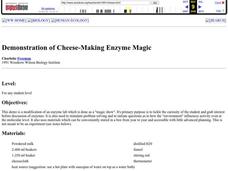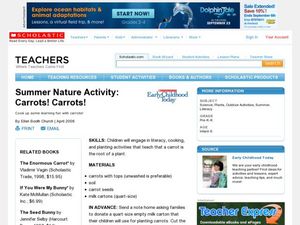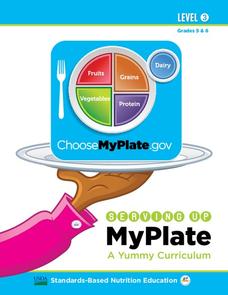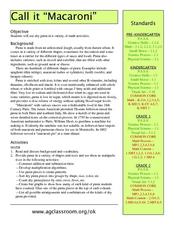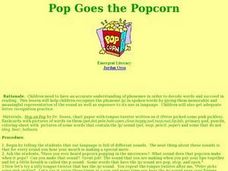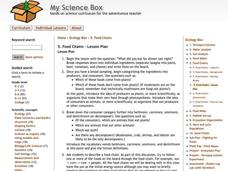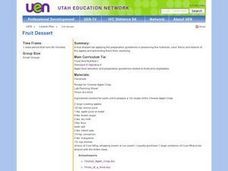Curated OER
Demonstration of Cheese-Making Enzyme Magic
Students watch a demo which is a modification of an enzyme lab which is done as a "magic show". It's primary purpose is to tickle the curiosity of the student and grab interest before discussion of enzymes. It is also used to stimulate...
Curated OER
Rennet Cultured Cheese
Fifth graders make cheese using two different methods. In this cheese making lesson, 5th graders make rennet cultured cheese following the step by step directions. They also make cheese using a genetically engineered bacteria that makes...
Curated OER
French Cheese
Learners discover how cheese in France is made. Using the internet, they read articles about the importance of cheese in the French culture. They identify the various French cheeses and locate the areas in France that manufacture...
Curated OER
Demonstration of Cheese-Making Enzyme Magic
Students participate in a modified demo enzyme lab, a "magic show." The purpose of the demo is to tickle the curiosity of the student and grab their interest before discussions of enzymes. Its purpose is also to stimulate problem solving...
Curated OER
Summer Nature Activity: Carrots! Carrots!
Young scholars investigate reading, cooking, and planting activities that teach that a carrot is the root of a plant. In this early childhood science lesson, students explore the world around them as they read The Carrot Seed and...
Curated OER
Cheese Please
Young scholars make cheese in their classroom! In this cheese lesson plan, students use bacteria and active culture to clot and age cheese that could be edible in the future.
US Department of Agriculture
Serving Up My Plate
Within three nutrition-themed, inquiry-based learning opportunities, pupils take notice of their eating habits; delve deep into the five food groups, gain experience in planning meals, participate in a taste test, and explore ads...
Curated OER
Sandwich Stratigraphy
Two activities are included in this resource. In the first, junior geologists model sedimentary rock layers, apply the Law of Superposition, and demonstrate folding and faulting of the Earth's crust. The model is technically a sandwich....
Curated OER
Call it "Macaroni"
Who knew there were so many fun educational opportunities featuring pasta? Scholars read a brief informational text about the history of pasta (note that "macaroni" is spelled two different ways, so address this if kids are reading...
Curated OER
Microorganism Multiplication
Sixth graders explore biology by viewing video clips in class. In this microorganism identification lesson plan, 6th graders identify the types of organisms that can feed small animals such as algae and protozoans. Students view video...
Curated OER
Introduce Vocabulary: Cows Can’t Fly
Students explore language arts by reading a story book in class. In this tier two vocabulary instructional activity, students read the book Cows Can't Fly and identify the use of certain vocabulary terms. Students define the selected...
Curated OER
Fracture Fundamentals: A Cheesy Analog
Students make small cuts (fracture nuclei) in processed cheese food and then apply stresses perpendicular or parallel to the cuts to see how fractures grow. They make predictions before each experiment and explain their results to the...
Curated OER
Tiny Bites: What Difference Could They Make?
Students explore how small "extra" bites of food can add significant calories to their diet. They estimate how many extra calories they add to their diets by just taking small bites of food throughout the day.
Curated OER
Edible Soil
Young scholars examine the components of the soil in their community. Following directions, they create their own edible soil to be eaten at the end of the activity. They discuss what makes soils around the world different from those...
Curated OER
POP! Goes the Popcorn!
Students complete a variety of activities based on examining corn and popcorn as one of the major crops of Kansas. They journal the results of the multidisciplinary activities in this unit.
Curated OER
Simple Machines
Third graders are introduced to the six types of simple machines and discover how they make tasks easier. In groups, they rotate between stations to experiment with the different types of simple machines. To end the lesson, they make a...
Curated OER
Enzymatic Reaction
Young scholars explore the effect enzymes have on reactions. They demonstrate the process of enzymatic reaction by making cheese. after experimentation, they answer a series of questions.
Curated OER
New Boxes from Old
Ninth graders take a rectangular box (e.g., a cereal box) and cut it up to make a new, cubical box with the same volume as the original. In so doing, they will discover that because the cubical box has less surface area than the...
Curated OER
Behold the Mold!
Students explore how mold grows on various food items. In this mold lesson plan, students predict how mold will grow on dry vs. wet food items, and chart their observations daily. Children develop a summary to aid them in a summative...
Curated OER
Bacteria
Students study the advantages and disadvantages of bacteria. In this bacteria lesson plan students draw and label the different types of bacteria.
Curated OER
Science as Inquiry: what is starch and how can we test it?
Sixth graders discuss nutrients and examine foods for starch. For this starch testing lesson, 6th graders use iodine to test foods for starch and record their results. Students complete a worksheet and self reflection.
Curated OER
Food Chains
Students describe food cahins and the role of organisms. Using a set of organism cards, they color code the organisms on their cards by their role in the food chain. Once a complete chain is identified, they glue it on a sheet of paper.
Curated OER
Fruit Dessert
Third graders complete a fruit lab applying the preparation guidelines in preserving the nutrients, color, flavor and texture of the apples and preventing them from oxidizing.
Curated OER
Helpful Microorganisms
Students study how some microorganisms are helpful and practical in foods. They work with microorganism in a number of food, such as yeast in bread and yogurt.



